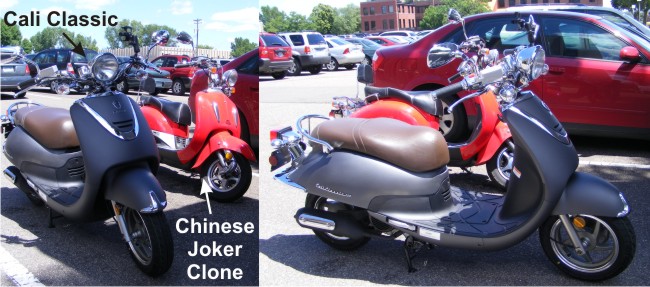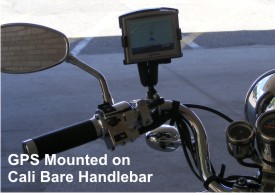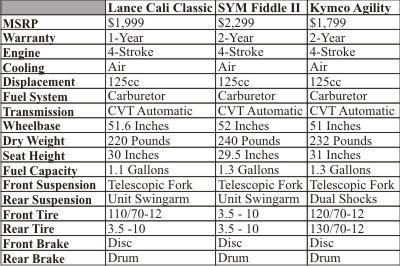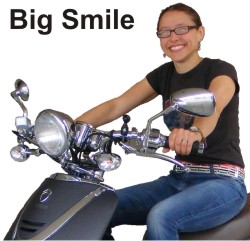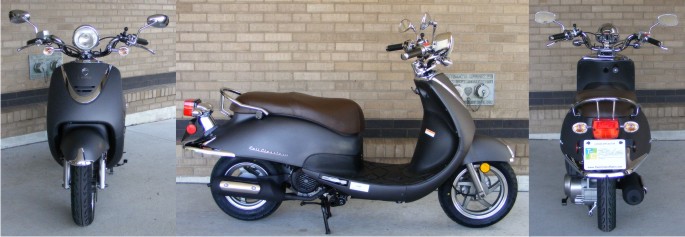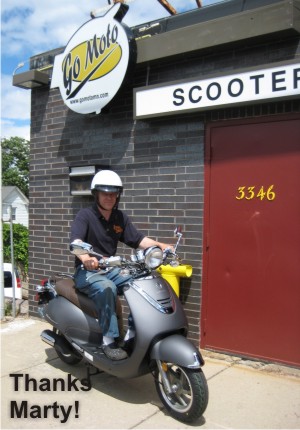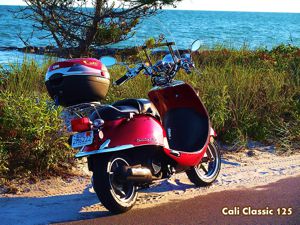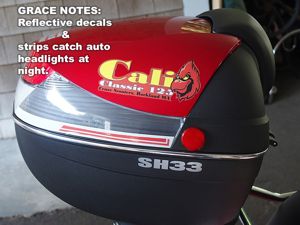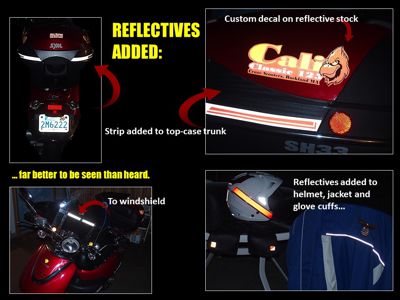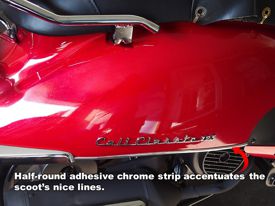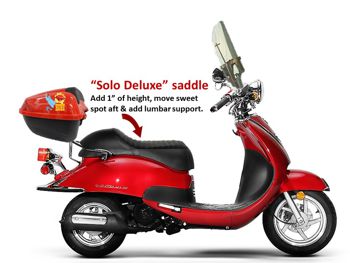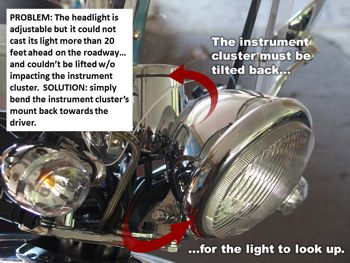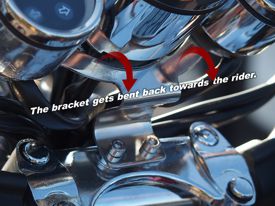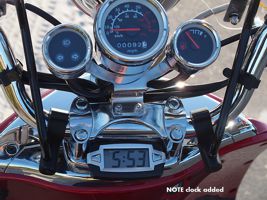 June, 2012
June, 2012
Another Perspective on the Cali Classic
Can the body style of a scooter prejudice a review? In 1996 Honda launched the “Joker” scooter in Japan (it was called the Shadow in Europe). It had a bulbous retro design and did quite well, especially with younger riders. It wasn’t long before Joker “clones” started coming out of mainland China in massive numbers. Even Italy got in on the game with the Aprilia Mojito. For a while in the US marketplace, there were so many different Joker clones that one could barely keep track of all the different names and importers, most of the scooters were of very low quality. By the time the Cali Classic hit the market, I admit that I had a oh-no-not-another-Joker-clone attitude about the scooter. Yes, the body style can prejudice a review(er).
I picked the Cali Classic up from Marty Mataya at GoMoto in Minneapolis. Marty is the local SYM and Lance dealer and is a great guy. Marty also carries one of the better mainland Chinese brands, CF Moto. Marty is one of the “good guy” dealers and has the knowledge and customer focus that keeps guys like me going on and on about how important it is to have a good dealer for ANY scooter brand.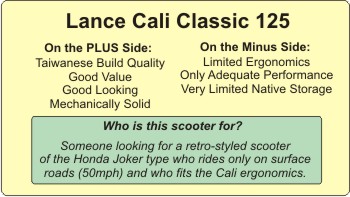
Though certainly not free of flaws, the Lance Cali Classic 125 is a good scooter and a very good value. If you want a Joker clone, go out and buy a Cali right now and know that you’ll be getting a good machine… or you can read on for more details and to see me further humbled by my own often baseless attitudes.
Speedometer Reading/Speed/Fuel Economy
Utilizing a GPS unit to perform some testing is a routine part of our reviews. With some scooters it can be a challenge to find a good mounting point. Not the case on the Cali Classic as there is ample bare bar area to attach stuff. Most scooters have speedometers that are pretty optimistic, they indicate faster than the actual speed and sometimes quite a bit faster. The Cali Classic more accurate than most being only about 7% optimistic. At an indicated 30 MPH the actual speed is 28 MPH. At an indicated 40 MPH the actual speed is 37 MPH and at an indicated 50 MPH the actual speed is 47 MPH. The odometer is a bit more accurate than the speedometer – an indicated 21.3 miles was actually 21 miles. The fastest speed I was able to achieve was 52 MPH. The speedometer indicated 55 MPH and the Lance specifications for the Cali list a top speed of 59 MPH. There are three factors in play here that likely impact top speed. In the first place, I am NOT a small person. At 220 pounds I am a larger load than a typical Cali buyer. In the second place, the scooter was new and not yet broken in. Third, I kept running out of road when doing top speed checks. The Cali is slow to accelerate about 45 MPH and I would often have to slow down for traffic or a stop light when trying to wring out those last few MPH. Fuel economy was 89 MPG which I consider quite good for a 125cc scooter carrying a big load with a not-yet-broken-in engine. The fuel tank holds just over a gallon so 90 miles or so is pretty close to the effective range of the Cali Classic.
Features
The Lance Cali Classic 125 is manufactured in Taiwan by SYM. SYM is a top tier manufacturer capable of quality that is equal to any manufacturer from Japan or Europe. The Cali Classic has a lot of similarity to SYM’s Fiddle II model, so I included that in the comparison. I also added the Kymco Agility 125 because it’s the only other sub-$2,000 new scooter that I think is of decent quality. Other than price and engine displacement, it’s really not a direct competitor of the Cali Classic because the style and ergonomics are so completely different. All three scooters have air-cooled, carbureted 125cc engines, disc front and drum rear brakes, a 51″ – 52″ wheelbase and weight 220 to 240 pounds. The SYM and Kymco both offer two-year warranties while the Cali Classic has a one-year warranty.
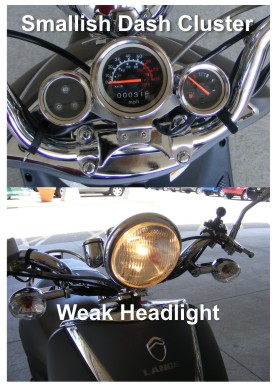
The three-pod dash cluster is smallish overall. The speedometer/odometer is located in the center and biased to miles with kilometers smaller and on the inside edge of the indicator. The fuel gauge is to the right and there are three indicator lights to the left, one for each turn signal and one for high-beam. These were very weak and I couldn’t see them at all in bright sunlight. The headlight is incandescent and fairly weak. Riding at night meant living with only adequate illumination of the road ahead. Of course the (arguably) greatest revival scooter of the past decade, the Genuine Stella, originally came equipped with an even weaker headlight and it didn’t hurt Stella sales at all. The turn signal and brake lights also utilize standard bulbs but are brighter than the headlight. On the plus side, the fuel gauge was a pretty accurate indicator of how much fuel was in the tank. A LOT of scooter fuel gauges seem to be more of a “yes” or “no” indicator – when on full you have an indeterminate quantity of fuel and the gauge will rocket to empty at some mysterious point.
There is a helmet/bag hook on the front that was strong enough to hold the handles of two cloth grocery bags securely. The underseat storage is VERY limited. 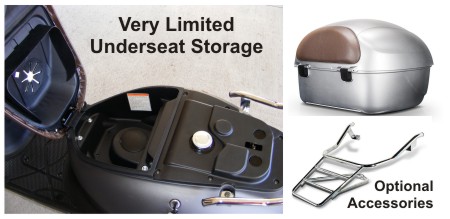
Riding Impressions
As I mentioned earlier, the Cali Classic 125 fired right up every time – warm or cold – and quickly settled into idle. Acceleration off the line was adequate and even up to about 45 MPH. Above that speed it takes rather a while to wring more out of the Cali.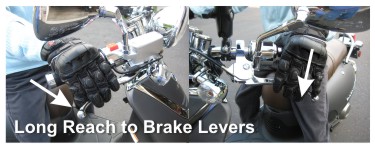
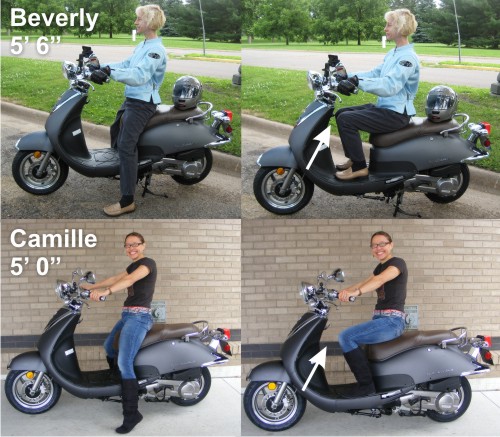
Bob from Scooterville (6′ 2″) also road the Cali Classic and, as expected, couldn’t find a comfortable position. Bob is a Genuine, Kymco, Vespa, Piaggio, Vectrix and Hyosung dealer and he was also riding the Cali actively looking for things to criticize. He did notice a fairly strong harmonic vibration from the powertrain when at a stop with the rear brake engaged, but really couldn’t find anything major to complain about. I do just have to mention how incredibly lucky we are in the Minneapolis/St. Paul area to have dealers like Bob and Marty who are competitors, but still friends and truly focused on their customers. I can’t think of very many places were one can get dealers to ride “other” products and know they will give honest opinions.
Having Camille run around briefly on the Cali Classic also brought up a very valid position. A person’s riding impressions of any given scooter will depend on what (if any) scooter they currently ride. Camille has had a TNG Venice (small 50cc) for several years and to her the Cali Classic felt incredibly smooth, roomy, and fast. I suspect a large number of Cali Classic 125 customers will be first-time scooter buyers. As long as they aren’t expecting lightning-fast performance, they will probably be very happy with the ride on the Cali.
Fit & Finish
The Cali Classic 125 has the best fit and finish of any Honda Joker clone I have seen. The body panels are perfectly aligned and the quality of assembly is top notch. There is a lot of shiny plastic (plastichrome some call it) that may or may not suit your personal taste, but it’s not cheaply executed. The switches, lights and other components look durable if not particularly high end. Here we enter into one of the areas that helps explain the price point on the Cali Classic. How can the same company that makes the $2,300 Fiddle II produce a VERY similar scooter for $300 less? I’m pretty certain that the components utilized on the Cali Classic, though of good quality, are cheaper than those utilized on the Fiddle II.
I spent a fair amount of time going over the Cali Classic, looking at the fasteners, body seams, hoses, electrical components and so forth and I will admit that my prejudices about this particular Joker clone were wrong. The scooter is put together very well and I would assume that it will hold up well.
Conclusions
I was more impressed with the Lance Cali Classic 125 than I expected to be. The build quality is very good. The performance is adequate and the fuel economy is very good. The look is appealing and the majority of people who saw the scooter liked it. I had to keep reminding myself that this is a $1,999 scooter. There’s just nothing else at that price point with the same mix of retro looks and Taiwanese quality out there. If I were getting one for myself, I would have the seat customized to move the rider position further back and I would add the rear luggage rack and probably a topcase. The Cali Classic is available in Butterscotch Yellow, Arctic White, Matte Black (reviewed), Metallic Silver, Ruby Red, Midnight Black and Sky Blue. A big THANK YOU goes out to Marty Mataya of GoMoto in Minneapolis Minnesota for facilitating this review.
David Harrington
Another Perspective on the Cali Classic 125
December 2020
Lawrence Brown has (very generously) offered up his scooter perspectives to Just Gotta Scoot in the past. This time he brings us a different perspective on the Lance Cali Classic 125.
Considering the Lance Cali Classic 125 by Lawrence Brown
At 74, I’m almost in my dotage. Two spinal surgeries and having a tree fall on me during a blizzard have left me with less leg strength than I’d like. After 55 years of riding all sorts of motorcycles and scooters, it was time to down-size. It isn’t as morbid as it sounds, but I’ve gone shopping for my last bike. This is it: the Cali Classic 125 by Lance, a subsidiary of Sym, made in Taiwan.
Nothing’s perfect but the Cali came closest. First of all, Sym / Lance makes damn good bikes. Their patented ceramic-lined cylinders offer superior wear and heat-dissipating properties, important in small air-cooled engines. If my back permitted longer rides, their 200i model adds another 10 mph to the top end. I’ve found the 125ccs gives me snappy acceleration off the line and powers me up past 55 with no problem… and 90% of the time, that’s all I want. (When shopping for a bike, you’ll save a lot of money by asking yourself what you’re really going to be doing with the bike 90% of the time. Get that bike and you’ll be happy 90% of the time at an affordable price.)
If you’ve never ridden a bike with “buckhorn” handlebars, you’re in for a treat. Ergonomically, it puts your hands just where they want to be at a natural angle. Your shoulders will relax. It just feels right. My first motorcycle in 1965 had buckhorns and no subsequent bikes did – until the Cali. I love it.
Aesthetically, the bike has sweet lines. It’s like a Vespa – but better-looking. (And cheaper) The duck-tail rear fender adds panache and keeps road spray completely off you. I’ve always wanted white-wall tires and for the 1st time, there are tires that will fit it – Shinko tires specifically. My old 700 pound bike is for sale and when it’s cashed out, I’ll be pimping out my Cali with Shinkos.
It’s a quiet bike. People will think you just rode by on a sewing machine. You can start the bike early in the morning and no one will wake up, not even in your own house. Neighbors will thank you. By the way, pay no attention to the LOUD BIKES SAVE LIVES clap-trap. You hear a siren in traffic and crane your neck to see which direction it’s coming from. Same with a bike. You hear the racket. OK, it’s a very loud motorcycle – but where the Hell is it? Waking babies up for miles around doesn’t make you a real man. It makes you a real jerk.
Loud colors save lives. People are idiots. They’re on their cell phones. You must make them see you! That’s why I got a red Cali. Don’t wear black and especially, don’t wear a black helmet. Up high where SUV drivers live, a yellow helmet… my white one with red reflective stripes… those get seen. And you are less apt to get hit. Wear bright colors. If your riding jacket doesn’t have reflective pin-stripes, get some iron-ons and be seen at night.
Put a reflective band of tape on your top-case. It’s up high and people will see it in their headlights at night – when a lot of biker accidents happen. Should the headlights ever fail, I added thin strips to my windshield to light me up to cars coming the other way. Hardware stores sell reflective plastic dots that self-adhere. Strips on my helmet light up and I added small reflectives to the cuffs of my riding gloves. I offer hand signals always in addition to the turn signals. The motion attracts attention – especially if your riding jacket is bright. The little cuff reflectives light up the motion at night for the guy behind you.
Other grace notes:
Automotive supply shops sell self-adhesive chrome strips in various thicknesses. A fine line of chrome extends the nice chrome fixture on your rear fender. I added more to accentuate the reflective red striping on my helmet. Chrome adds some flash in sunlight… another way to be seen.
Things I’d change:
The Cali has the worst under-seat storage of any scooter I’ve seen. So the top-case trunk option is a must. And you’ll want one anyway. Add reflectives when you get one.
Even the Lance video clips show the rider sitting on the hump behind the sweet spot. It’s a generous, wide and well-padded seat. I smaller rider would be happy – and if you take a passenger, you’ll want the seat just as it is. Otherwise, Lance could make some aftermarket money offering a “Solo Deluxe” seat, an inch higher, sweet spot moved aft, and a generous lumbar support. Combine with the buckhorn handlebars and you’d have a scooter that someone would sit on in the showroom and say, “DAMN!” I’ll probably order a spare seat and see if someone local can make me one.
Back roads around my place empty out nicely at night. Especially when the moon’s up, I like to go riding. The headlight does a nice job, but it was angled down to cast its light on the highway only a car’s length away. No problem, I thought. It’s a motorcycle-style headlight; it’s adjustable. Except it isn’t. The back of the light bumps into the instrument cluster! I pointed this out to my dealer’s mechanic and we used two crescent wrenches to get a grip on the instrument cluster’s bracket, which we carefully bent back towards the driver. 15 – 20 degrees does it nicely. Now the light could be lifted up – and all is well. This is a tiny modification the factory should do going forward. It won’t cost them a dime, they’ll have a better bike, and customers shouldn’t have to risk having the bracket break on them trying to do it themselves.
Speaking of grace-notes… the Cali’s instrument cluster looks very sharp. When you angle it back towards you, sun-glare is less apt to obscure your ability to read them. The Cali doesn’t have a clock – but automotive stores sell stick-on battery-powered clocks. I got a double-sided sticky Scots brand pad, cut a strip to size and added a clock to the instruments. Chrome, it looks like factory installed.
Lance offers a windshield for the Cali Classic. It certainly adds to riding comfort. Until I get a custom seat made, I added a pad and put it where I needed it. And there I am. I like messing around with my bikes – and the Cali gives me just enough things to do. It’s economical to buy and easy on gas. My dealer has a full inventory of parts and the bikes are built to run hard and last long.
Here’s the thing. You want to really like riding the bike you get, just for pure pleasure even if you have nowhere particular to go. And the Cali has that in spades. The pick-up is snappy. The steering is confident and flickable. The suspension is very effective – and with a bad back, that was a must. Maybe I’d have liked to see a disk brake aft, not a drum, but the bike stops very effectively without getting squirrely. So I’m happy. Then you finally get off and start to walk away. And here’s your final test. Will you want to glance back over your shoulder for one last look? Yes, you will. It’s that good.

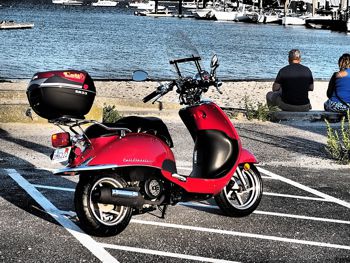
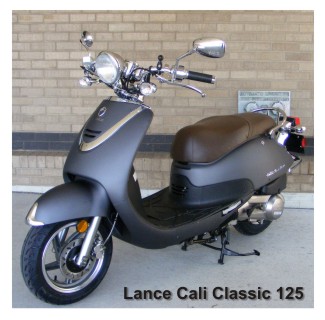 June, 2012
June, 2012